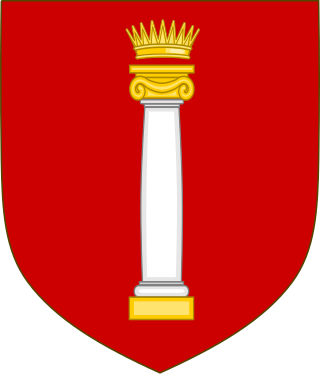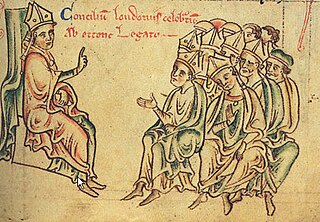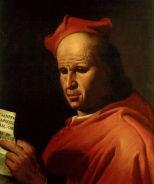
The House of Colonna, also known as Sciarrillo or Sciarra, is an Italian noble family, forming part of the papal nobility. It was powerful in medieval and Renaissance Rome, supplying one pope and many other church and political leaders. The family is notable for its bitter feud with the Orsini family over influence in Rome, until it was stopped by papal bull in 1511. In 1571, the heads of both families married nieces of Pope Sixtus V. Thereafter, historians recorded that "no peace had been concluded between the princes of Christendom, in which they had not been included by name".

Pope Honorius III, born Cencio Savelli, was head of the Catholic Church and ruler of the Papal States from 18 July 1216 to his death. A canon at the Basilica di Santa Maria Maggiore, he came to hold a number of important administrative positions, including that of Camerlengo. In 1197, he became tutor to the young Frederick II. As pope, he worked to promote the Fifth Crusade, which had been planned under his predecessor, Innocent III. Honorius repeatedly exhorted King Andrew II of Hungary and Emperor Frederick II to fulfill their vows to participate. He also gave approval to the recently formed Dominican and Franciscan religious orders.

Pope Celestine III, was the head of the Catholic Church and ruler of the Papal States from 30 March or 10 April 1191 to his death in 1198. He had a tense relationship with several monarchs, including Emperor Henry VI, King Tancred of Sicily, and King Alfonso IX of León.

Pope Innocent III, born Lotario dei Conti di Segni, was the head of the Catholic Church and ruler of the Papal States from 8 January 1198 until his death on 16 July 1216.
Sylvester IV, born Maginulf, was a claimant to the Papacy from 1105 to 1111 in opposition to Paschal II. A priest before his election, he was probably a native of Rome. He had the backing of the Roman militia and initially of the Holy Roman Emperor, Henry IV, who later forced him to abdicate. Today he is regarded as an antipope.

The Frangipani family was a powerful Roman patrician clan in the Middle Ages. The family was firmly Guelph in sympathy. The name has many spellings, which include Frangipane, Freiapane, Fricapane and Fresapane. In his Trattatello in laude di Dante, Boccaccio traces the descent of Dante from the family.

Otto of Tonengo was an Italian papal diplomat and cardinal, first as deacon of San Nicola in Carcere from 1227 and then as bishop of Porto e Santa Rufina from 1244.
Giovanni Battista Savelli was an Italian Roman Catholic cardinal. He was born into the aristocratic Savelli family, which had produced two popes: Honorius III (1216–1227) and Honorius IV (1285–1287) and numerous cardinals carrying this surname: Bertrando, Silvio, Giulio, Fabrizio, Paolo and Domenico Savelli.
The 1241 papal election saw the election of Cardinal Goffredo da Castiglione as Pope Celestine IV. The election took place during the first of many protracted sede vacantes of the Middle Ages, and like many of them was characterized by disputes between popes and the Holy Roman Emperor. Specifically, the election took place during the war between Frederick II, Holy Roman Emperor and the Lombard League and deceased pontiff, Pope Gregory IX, with Italy divided between pro-Papal and pro-Imperial factions known as the Guelphs and Ghibellines.
Pietro Senex was Cardinal-Bishop of Porto from 1102 until his death. He was born probably in Rome.

Raniero Capocci, also known as Ranieri, Rainier, or Rainerio da Viterbo was an Italian cardinal and military leader, a fierce adversary of emperor Frederick II.
Pietro Capocci was a Roman Catholic cardinal, nominated by Pope Innocent IV in the consistory of 28 May 1244, with the cardinal-diaconate of San Giorgio in Velabro.

Thomas of Capua, also called Tommaso di Eboli, was an Italian prelate and diplomat. He served as the archbishop-elect of Naples from 1215 until 1216 and then as a cardinal until his death. He administered the diocese of Albano between 1218 and 1222 and was the papal legate in the kingdom of Italy from November 1236 until October 1237. He was the most important of Pope Gregory IX's negotiators with the Emperor Frederick II between 1227 and 1237.
John of Ferentino, in Italian Giovanni da Ferentino, was an Italian notary, curialist and cardinal of the Catholic Church. He served as the cardinal deacon of Santa Maria in Via Lata from 1204 until 1212 and then as the cardinal priest of Santa Prassede until his death. He served as an apostolic legate to England in 1206 and as rector of the Papal states in Campania in 1217.
Gerardo da Sesso was an Italian monk, bishop and cardinal of the Catholic Church.
Peter of Capua, known in Italian as Pietro Capuano, was an Italian theologian and clergyman who taught at the University of Paris from 1206 to 1218, was briefly patriarchate-designate of Antioch in 1219 and was then cardinal-deacon of San Giorgio in Velabro from 1219 until his death. The scion of an illustrious family from the Kingdom of Sicily and educated at Paris, he became known in Rome as a friend of the French church and of the Holy Roman Emperor.
Gil Torres was a Leonese cleric and the cardinal-deacon of Santi Cosma e Damiano from 1216 until his death.
Berthold of Urslingen was a German nobleman whose career was spent almost entirely in central Italy, where his family had a claim to the duchy of Spoleto.
Enrico da Settala, sometimes anglicized Henry of Settala, was the archbishop of Milan from 1213 until his death.
Stefano de Normandis dei Conti was an Italian cardinal. He was a nephew of Pope Innocent III.








